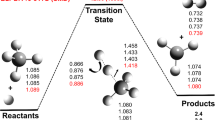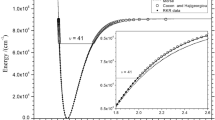Abstract
We present a simple virial-type extension to the modified Redlich-Kwong (MRK) equation for calculation of the volumes and fugacities of H2O and CO2 over the pressure range 0.001–50 kbar and 100 to 1400°C (H2O) and 100 to 1600°C (CO2). This extension has been designed to: (a) compensate for the tendency of the MRK equation to overestimate volumes at high pressures, and (b) accommodate the volume behaviour of coexisting gas and liquid phases along the saturation curve. The equation developed for CO2 may be used to derive volumes and fugacities of CO, H2, CH4, N2, O2 and other gases which conform to the corresponding states principle. For H2O the measured volumes of Burnham et al. are significantly higher in the range 4–10 kbar than those presented by other workers. For CO2 the volume behaviour at high pressures derived from published MRK equations are very different (larger volumes, steeper (∂P/∂T)V, and hence larger fugacities) from the virial-type equations of Saxena and Fei. Our CORK equation for CO2 yields fugacities which are in closer agreement with the available high pressure experimental decarbonation reactions.
Similar content being viewed by others
References
Berman RG (1988) Internally-consistent thermodynamic data for minerals in the system Na2O−K2O−CaO−MgO−FeO−Fe2O3−Al2O3−SiO2−TiO2−H2O−CO2. J Petrol 29:445–522
Bottinga Y, Richet P (1981) High pressure and temperature equation of state and calculation of the thermodynamic properties of gaseous carbon dioxide. Am J Sci 281:615–660
Bulakh AG (1979) Thermodynamic properties and phase transitions of H2O up to 1000°C and 100 kbar. Internat Geol Rev 21:92–103
Burnham CW, Holloway JR, Davis NF (1969) Thermodynamic properties of water to 1000°C and 10000 bars. Geol Soc Am Spec Pap 132
Delany JM, Helgeson HC (1978) Calculation of the thermodynamic consequences of dehydration in subducting oceanic crust to 100 kb and >800°C. Amer J Sci 278:638–686
Eggler DH, Kushiro I, Holloway JR (1979) Free energies of decarbonation reactions at mantle pressures 1. Stability of the assemblage forsterite-enstatite-magnesite in the system MgO−SiO2−CO2−H2O to 60 kbar. Amer Miner 64:288–293
Ferry JM, Baumgartner L (1987) Thermodynamic models of molecular fluids at the elevated temperatures and pressures of crustal metamorphism. Reviews in Mineralogy (Mineral Soc Amer) 17:323–365
Haar L, Gallagher JS, Kell GS (1984) NBS/NRC steam tables. Thermodynamic and transport properties and computer progams for vapor and liquid states of water in SI units. Hemisphere publishing McGraw-Hill, New York
Halbach H, Chatterjee ND (1982) An empirical Redlich-Kwong-type equation of state for water to 1000°C and 200 kbar. Contrib Mineral Petrol 79:337–345
Haselton HT Jr, Sharp WE, Newton RC (1978) CO2 fugacity at high temperatures and pressures from experimental decarbonation reactions. Geophys Res Lett 5753–756
Holland TJB, Powell R (1990) An enlarged and updated internally consistent thermodynamic dataset with uncertainties and correlations: the system K2O−Na2O−CaO−MgO−MnO−FeO−Fe2O3−Al2O3−TiO2−SiO2−C−H2−O2. J Metam Geol 8:89–124
Holloway JR (1977) Fugacity and activity of molecular species in supercritical fluids. In: Fraser DG (ed) Thermodynamics in geology. Reidel, Dordrecht-Holland, pp 161–181
Irving AJ, Wyllie PJ (1975) Subsolidus and melting relationships for calcite, magnesite, and the join CaCO3−MgCO3 to 36 kb. Geochim Cosmochim Acta 39:35–53
Kennedy GC, Holser WT (1966) Pressure-volume-temperature and phase relations of water and carbon dioxide. Geol Soc Amer Mem 97:374–383
Kerrick DM, Jacobs GK (1981) A modified Redlich-Kwong equation for H2O, CO2 and H2O−CO2 mixtures at elevated pressures and temperatures. Amer J Sci 281:735–767
Markgraf SA, Reeder RJ (1985) High temperature refinements of calcite and magnesite. Amer Mineral 70:590–600
McCormack KE Schneider WG (1950) Compressibility of gases at high temperatures. IV. carbon dioxide in the temperature range 0°–600°C, and pressures up to 50 atmospheres. J Chem Phys 19:1269–1272
Mel'nik YP (1978) Thermodynamic properties of carbon monoxide and methane at high temperatures and pressures—a new correlation based on the principle of corresponding states. Geokhimiya 11:1677–1691
Newton RC, Sharp WE (1975) Stability of forsterite + CO2 and its bearing on the role of CO2 in the mantle. Earth Planet Sci Lett 26:239–244
Powell R, Holland TJB (1985) An internally consistent thermodynamic dataset with uncertainties and correlations: 1. Methods and a worked example. J Metam Geol 3:327–342
Powell R, Holland TJB (1988) An internally consistent thermodynamic dataset with uncertainties and correlations: 3 Applications to geobarometry, worked examples and a computer program. J Metam Geol 6:173–204
Presnall DC (1969) Pressure-volume-temperature measurements on hydrogen from 200° to 600°C and up to 1800 atmospheres. J Geophys Res 74: 6026–6033
Press WH, Flannery BP, Tukolsky SA, Vetterling WT (1989). Numerical recipes: the art of scientific computing. {FORTRAN, Pascal, and C versions available}. Cambridge University Press, Cambridge, UK
Redfern SAT, Salje E, Navrotsky A (1989) High temperature enthalpy at the orientational order-disorder transition in calcite: implications for the calcite/aragonite phase equilibrium. Contrib Mineral Petrol 101:479–484
Redlich O, Kwong JNS (1949) On the thermodynamics of solutions. V. An equation of state. Fugacities of gaseous solutions. Chem. Rev 44:233–244
Ryzhenko BN, Volkov VP (1971) Fugacity coefficients of some gases in a broad range of temperatures and pressures. Geokhimiya 7:760–773
Saxena S, Fei Y. (1987a) High pressure and high temperature fluid fugacities. Geochim Cosmochim Acta 51:783–791
Saxena S, Fei Y (1987b) Fluids at crustal pressures and temperatures 1. Pure species. Contrib Mineral Petrol 95:370–375
Shmonov VM, Shmulovich KI (1974) Molar volumes and equations of state for CO2 between 100–1000°C and 2000–10000 bars. Nauk USSR Doklady 217:935–938
Shmulovich KI, Shmonov VM (1975) Fugacity coefficients of CO2 from 1.0132 to 10000 bar and from 450° to 1300°K. Geokhimiya 4:551–555
Tsiklis DS, Linshits LR, Tsimmerman SA (1971) Measurement and calculation of molar volume of CO2 at high pressure and temperature. Teplofiz Svoistva Veschesty Mater 3:130–136
Vukalovich MP, Altunin VV (1968) Thermophysical properties of carbon dioxide. Collet's, London, UK
Author information
Authors and Affiliations
Rights and permissions
About this article
Cite this article
Holland, T., Powell, R. A Compensated-Redlich-Kwong (CORK) equation for volumes and fugacities of CO2 and H2O in the range 1 bar to 50 kbar and 100–1600°C. Contr. Mineral. and Petrol. 109, 265–273 (1991). https://doi.org/10.1007/BF00306484
Received:
Accepted:
Issue Date:
DOI: https://doi.org/10.1007/BF00306484




